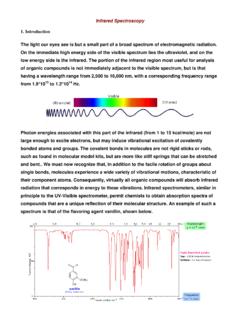Transcription of LAKELAND LABORATORIES LIMITED
1 LLLLLAKELANDLABORATORIESLIMITEDM anufacturers of Speciality SurfactantsAmphotericsPhosphate EstersImidazolinesWax EmulsionsCHEMICALS FOR INDUSTRYC ertificate EstersWhy? Which? Where?2 Why phosphate esters ?INTRODUCTIONP hosphate esters are 100% active anionic surfactants whichare produced as the free acid by either of two chemical are produced by the reaction of either alcohols,alcohol ethoxylates or phenyl ethoxylates with polyphosphoricacid, whereas mixtures of mono and diesters are produced byreaction of the same feedstock with phosphorous esters are highly versatile surfactants offering a wide range of properties and applications. The mainadvantages of phosphate esters over many other surfactantsare their alkali stability and solubility. They are excellenthydrotropes and are effective coupling agents which give outstanding wetting, emulsification and detergency. As suchthey are used widely in emulsion polymerisation, textileauxiliaries, maintenance chemicals, metal finishing, and many other esters have a unique range of properties which areexploited in the production of specialised chemical processingaids for industry.
2 Being stable in high concentrations of alkali,they are especially useful in household and maintenancecleaning products, where high active heavy duty products are EstersLakeland manufacture phosphate esters based on either alcohols, ethoxylated alcohols or phenyl basedThe R-group is derived from a specific alcohol basedThe R-group is derived from a specific ethoxylated phenol basedThe R-group is derived from a specific ethoxylated (1%)RMOLESMONO/DI-%(Typical)EOESTERACTIV E(Nominal)RATIO(Nominal)(Typical) : : 11009 - 10 neatC8H1701 : : : : : : : : : : : 11009 - 10 neatC6H5440 : : : : : 1100 phosphate esters are available as the free acid and in mostcases as the potassium or sodium of the useful properties are: Anionic character. Anionic surfactants are the preferred choice for use in textile auxiliaries. 100% active. Economic for shipment, easily incorporated into powder blended products. In some cases their emulsifying properties make them ideal for use in oil/water systems.
3 phosphate esters can be neutralised by alkaline earth metals or amines, adding to their versatility. Foaming properties of phosphate esters varies, from high to low. The variety of wetting, foaming and surface tension reductionproperties helps the formulator to develop the required product. Very good hydrotroping properties which enable high active productsto be produced without the use of additional auxiliary hydrotropes. Stability in alkali and builders enabling heavy duty cleaners to be formulated. Lubricating properties that enable phosphate esters to beused in metal working fluids and water based lubricants. Excellent free rinsing properties leading to smear free surfaces. Corrosion inhibition and prevention as well as load carryingproperties make phosphate esters ideal for use in metalworking. In general low orders of toxicity and relatively low orders of irritation for the potassium salts. Some phosphate esters exhibit solvent Value(mgKOH/g)(Typical)PHOSPHATED ALCOHOLSPA 100 Clear pale brown viscous liquid950PA 800 Clear viscous pale brown liquid360PA 800K Clear pale amber liquidN/APA 801 Clear light brown liquid370 PHOSPHATED ALCOHOL ETHOXYLATESPAE 802 Clear colourless to pale amber liquid190 PAE 106 Clear viscous pale brown to brown liquid160 PAE 126 Clear viscous pale brown to brown liquid190 PAE 136 Clear viscous pale brown to brown liquid210 PAE 147 Homogeneous viscous pale yellow liquid 220 PAE 176 Yellow viscous liquid clear at 40 C 150 PAE 185 Amber paste clear liquid at 40 C 150 PAE 1780 Light brown solid30 PHOSPHATED PHENOL ETHOXYLATESPPE 604 Clear viscous amber liquid320 PPE 604 KClear colourless to pale amber liquid N/APPE 154 Clear viscous amber to brown liquid 240 PPE 156 Clear viscous amber to light brown liquid 90 PPE 159 Clear viscous amber to light brown liquid 100 PPE 1513 Clear viscous amber liquid2302 GENERAL INFORMATIONPRODUCT
4 PROPERTIESW hich phosphate Ester?The case has been made WHY phosphate esters are used. Theproblem for the formulator then becomes - WHICH PHOSPHATEESTER ? A series of comparative tests have been carried out: Surface tension reduction Wetting properties Solubilisation Foam height/stabilityThe detailed results that follow are designed to help the formulator decide which phosphate ester best suits the Tension ReductionPHOSPHATED ALCOHOLSPHOSPHATED ALCOHOL ETHOXYLATESPHOSPHATED PHENOL 1513 Axis = Conc. %aiy Axis = Properties30035025020015010050017121 7121 712 Ross Miles Foam Heights, ASTM D1173, active solutions performed at pH 1, 7 and 7121 7121 7121 7121 7121 7121 71230035025020015010050017121 7121 7121 7121 712 FOAM HEIGHT, mmPA 100 PA 800 PA 801 pHPPE 1513 PPE 154 PPE 156 PPE 159 PPE 604pHFOAM HEIGHT, mmPAE 802 PAE 106 PAE 126 PAE 136 PAE 147 PAE 176 PAE 185 PAE 1780 FOAM HEIGHT, It should be noted that some phosphate esters are prone to hydrolysis in strong mineral acids over a long period of RANGEKEYpHpHpHpH= Foam Height,initial= Foam Height.
5 After 5 minsSolubilisation PropertiesPHOSPHATED ALCOHOLSPA 100 42 CNot Stable20 CPA 800 C76 CPA 80182 C87 CPHOSPHATED ALCOHOL ETHOXYLATESPAE 80254 C22 CPAE 106>100 C66 C48 CPAE 12689 C86 C69 CPAE 13690 C82 C82 CPAE C72 C>100 CPAE 17681 C90 C>100 CPAE 18570 C56 C>100 CPAE CNot StableNot StablePHOSPHATED PHENOL ETHOXYLATESPPE 1513 C54 C66 CPPE 154 C>100 C>100 CPPE 15649 C36 CNot StablePPE 15977 C90 CPPE 604 60 C67 C5g Alcohol Ethoxylate 5g Alcohol Ethoxylate 5g Phenol Ethoxylate 10g TKPP 5g STPP 10g TKPP 2g Phos Ester 5g METSO 5g STPP 83g Water3g Phos Ester 4g Phos Ester 82g Water76g WaterPRODUCTRESULTS (Seconds)1% Active Solution Active SolutionpH 1 pH 7 pH 12 pH 1 pH 7 pH 12 PA 800 Insoluble11 Insoluble1016PA 801 Insoluble11 Insoluble710 PAE 80200017 910 PAE 106111201422 PAE 1261615231646 PAE 1361814181221 PAE 14741418 14 1630 PAE 176837457506789 PAE 1852259141184225125 PPE 1513 322795403890 PPE 154 11617 11 1720 PPE 1561111101011 PPE 159152024403030 The following table is designed to show the formulator the effectiveness of each phosphate ester as a solubiliser in three different systems.
6 The solubilisation property is illustrated by the cloud point in C for each = Alcohol Ethoxylate (C13-15 + 9EO) = Tetrapotassium Pyrophosphate (50%) = phosphate Ester = Sodium Metasilicate 5H2O = Sodium Tripolyphosphate = Nonyl Phenol + 9 PropertiesUnder testing parameters of ASTM D2281, Skein test, the following phosphate esters all produced wetting times of under 4 minutes. The following table shows actual times in ESTERFORMULATION 1 FORMULATION 2 FORMULATION 3 SolubilityThe table below is a rough guide to the solubility of LAKELAND phosphate esters in three different types of media; aqueous, alkaline and a hydrophobic (10-30%)WHITE SPIRITPA 100 Infinitely solubleSolubleInsolublePA 800 InsolubleInsolubleSolublePA 801 Forms instable dispersionsInsolubleSolublePAE 802 DispersableSoluble at 10 - 20%SolublePAE 106 SolubleSoluble at 10 - 20%SolublePAE 126 SolubleSolubleSolublePAE 136 Soluble hazy solution obtainedSolubleSolublePAE 147 SolubleSolubleSolublePAE 176 Emulsion obtainedSoluble at low concentrationsSolublePAE 185 Emulsion obtainedDispersable at low concentrationsSolublePAE 1780 SolubleInsolubleInsolublePPE 154 Emulsion obtainedSolubleSolublePPE 156 DispersesSoluble in 10% NaOHSolublePPE 159 SolubleSoluble in 10% NaOHDispersesPPE 1513 SolubleSoluble in 10% NaOHInsolublePPE 604 SolubleSolubleVirtually insolubleCorrosion InhibitionPhosphate esters exhibit good corrosion inhibition properties either as the free acid or as the metal/amine salt.
7 The triethanolamine salt of phosphate esters give optimum corrosion protection in both water and oil-based Lubricant AdditivesPhosphate esters have useful properties which enable them to be formulated into cutting and grinding fluids as anti-wear and anti-corrosive additives. phosphate esters are also used in water-based hydraulic fluids as a lubricant to decrease pump wear and inhibit corrosion. They are also used in the manufacture of greases, drawing compounds, chain belt lubricants and gear esters General InformationPRODUCT CHEMICAL PACK SIZE/ VISCOSITY CAS/ DATANAMENAME20 CWEIGHTS(cPs/20 C)EINECSSHEETPA 100 Methyl typical250 kgs350 typicalCAS Number: 812-00-01500 EINECS Number: 212-379-1PA 800 2-ethylhexyl typical200 kgs200 typicalCAS Number: 12645-31-71600 EINECS Number: 235-741-0PA 800K2-ethylhexyl phosphate typical200 kgs200 typicalCAS Number: 68550-93-61601 EINECS Number: 271-355-9PA 801n-octyl typical200 kgs200 typicalCAS Number: 3115-39-71602 PolymerPAE 802 Poly(oxy-1,2-ethanediol)-hydro-hydroxy, mono typical200 kgs300 typicalCAS Number: 68909-65-91710C8branched alkyl ether, phosphatePolymerPAE 106 Poly(oxy-1,2-ethanediol)-hydro-hydroxy, mono typical200 kgs3000 typicalCAS Number.
8 68909-65-91800C10branched alkyl ether, phosphatePolymerPAE 126 Poly(oxy-1,2-ethanediol)-hydro-hydroxy, mono typical200 kgs3000 typicalCAS Number: 68909-65-91900C12branched alkyl ether, phosphatePolymerPAE 136 Poly(oxy-1,2-ethanediol)-hydro-hydroxy, mono typical200 kgs3000 typicalCAS Number: 68909-65-92000C13branched alkyl ether, phosphatePolymerPAE 147 Poly(oxy-1,2-ethanediol)-hydro-hydroxy, mono typical200 kgs3000 typicalCAS Number: 68909-65-92100C14branched alkyl ether, phosphatePolymerPAE 176 Poly(oxy-1,2-ethanediol)-hydro-hydroxy, mono typical200 kgs20000 typical CAS Number: 68909-65-92105C8to C22 branched alkyl ether, phosphatePolymerPAE 185 Poly(oxy-1,2-ethanediol)-hydro-hydroxy, mono typical200 kgs2000 typicalCAS Number: 68909-65-92110C18 branched alkyl ether, phosphatePolymerPAE 1780 Poly(oxy-1,2-ethanediol)-hydro-hydroxy, mono typical200 kgsSolidCAS Number: 39464-69-22107C17 branched alkyl ether, phosphatePolymer PPE 604 Poly(oxy-1,2-ethanediol) typical250 kgs15000 typical CAS Number: 39464-70-52500phosphatePolymerPPE 604 KPoly(oxy-1,2-ethanediol), phenyl- typical200 kgs600 typicalCAS Number: 39464-70-52550phosphate potassium saltPolymerPPE 154 Poly(oxy-1,2-ethanediol) typical200 kgs2000 typicalCAS Number: 68909-65-92295phosphatePolymerPPE 156 Poly(oxy-1,2-ethanediol) typical200 kgs2000 typicalCAS Number: 39464-64-72300phosphatePolymerPPE 159 Poly(oxy-1,2-ethanediol) typical200 kgs2000 typicalCAS Number: 39464-64-72400phosphatePolymerPPE 1513 Poly(oxy-1,2-ethanediol) typical200 kgs40000 typical CAS Number: 39464-64-72600phosphatePolymer7 Hard Surface CleanersDue to their alkali tolerance, phosphate esters have specific uses in heavyduty alkaline cleaners.
9 As well as having excellent detergent properties, phosphate esters also possess hydrotroping properties which assist in the formulation of high active alkaline cleaners, oven cleaners and DetergentsPhosphate esters can be used in spray dried, powder blended and liquidlaundry detergents as low foaming detergent/hydrotropes. High activedetergents with outstanding cleaning properties can be prepared bycombining LAKELAND PPE604 with LAKELAND AMA LF40 or AMA LF70 salt free amphoteric surfactants. In liquid products, extra alkali is required to neutralise phosphate and LeatherPhosphate esters are the preferred surfactant type for textile and leatherprocessing because of their anionic, wetting, low foaming, alkali toleranceand building/hydrotropic properties. LAKELAND PA800 and PAE802 arewidely used as wetting agents with low foaming properties. The amine saltsof phosphate esters are used as emulsifiers in solvent scouring PPE159 is used as a levelling agent in the direct dying of is used in jet dying machines to pre-scour and remove lubricantfrom knitted polyester.
10 PAE176 is used as a component in leatherprocessing Film RemovalSmall quantities of LAKELAND PPE159 combined with LAKELAND amphotericsimprove free rinsing properties of traffic film remover. This is particularlyimportant in hard water and Glass RinsingPhosphate esters such as PPE 604K are widely used in combination withEO/PO copolymers in the manufacture of rinse aids for automated dishand glass washing systems. The pH of the rinse aid is made sufficientlyacidic with citric or phosphoric acid to neutralise any residual alkali fromthe cleaning cycle. As many biodegradable EO/PO copolymers have lowcloud points and poor solubility, a low foaming hydrotroping phosphateester such as PPE604K can be used to raise the cloud point to 50 C. This ensures that the rinse aid does not phase separate if the temperature rises above the cloud point of the EO/PO AdditivesMany agricultural adjuncts such as herbicides are required in watersolution for application to foliage. phosphate esters are ideal foremulsification/solubilisation of additives into water together with goodwetting to ensure optimum spreading onto a leaf s surface.







